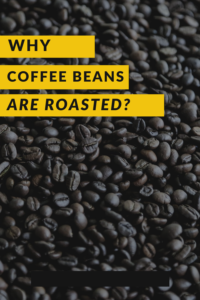- You are here:
- Home »
- Coffee Beans
- » Why Are Coffee Beans Roasted?
Why Are Coffee Beans Roasted?
I, like so many adults, cannot start my day properly if I do not have a cup of coffee in the morning. But when I stare into that cup, it creates a deceivingly simple illusion of how that coffee go there in the first place. Like many products and household foodstuffs, coffee is heavily processed before finding it’s way into your home. One of these important processes is the roasting of the coffee beans. Why are coffee beans roasted? The answer is quite simple. The coffee beans would literally have no flavor or aroma without being roasted first. But to appreciate why coffee beans are roasted, we must first discuss where coffee beans come from.

Coffee Cherries
Admittedly, before I learned about how coffee is harvested I imagined it was similar to a nut. I thought it would have an exterior shell. The truth is that coffee actually comes from a fruit. The fruit itself is edible, however, the skin is not much bigger than the beans inside. Imagine trying to eat grapes when the seeds are just about the size of the grape itself. It’s not very appealing.
At this stage, recently harvested coffee beans do not look as you imagine them in commercials or how they look in the coffee bag. At this point the coffee beans are actually quite pale or green depending on what species they come from. But more importantly, they possess no flavor or aroma.
Why Are Coffee Beans Roasted?
This is where the magic happens. Although the harvested coffee beans have the chemical makeup that makes a tasty cup of joe, the chemicals that make coffee what it is cannot escape the exterior of the structure of the coffee bean. Only until the bean is roasted, a process that breaks down the external structure of the bean, can you taste the coffee.
Every coffee company will have different patented ways in which they roast their beans. But ultimately, it boils down to the temperature that the beans were roasted at. This one is intuitive, lighter roasts were cooked at lower temperatures than darker roasts. Personally, I have always favored the lighter roasts myself.
Light Versus Dark Roasts
Not everyone enjoys coffee for its hedonistic values though. For some, drinking coffee is merely a pragmatic activity to ensure a successful work day. If this is the case, lighter roasts of coffee contain more caffeine. The reason is that the caffeine molecules get burnt up during the roasting process of the bean. Although darker roasts may feature a more intense flavor and aroma, they have considerably less caffeine than lighter roasts.
Roasting Your Own Beans
For some coffee aficionados, you may want to try your hand at roasting coffee beans yourself. I have heard stories that some people will roast beans in a toaster oven, or even in a frying pan. But most will tell you that it is best to use a gas/propane barbecue and a stove top popcorn maker. The reason for the barbecue is because roasting the beans can be pungent, and not in an attractive way. So for some it is better to roast outside. The stove top popcorn maker must have a mechanism that would allow your to rotate the beans. This will ensure the coffee beans are thoroughly roasted. Just remember to keep rotating those beans as you cook them.
